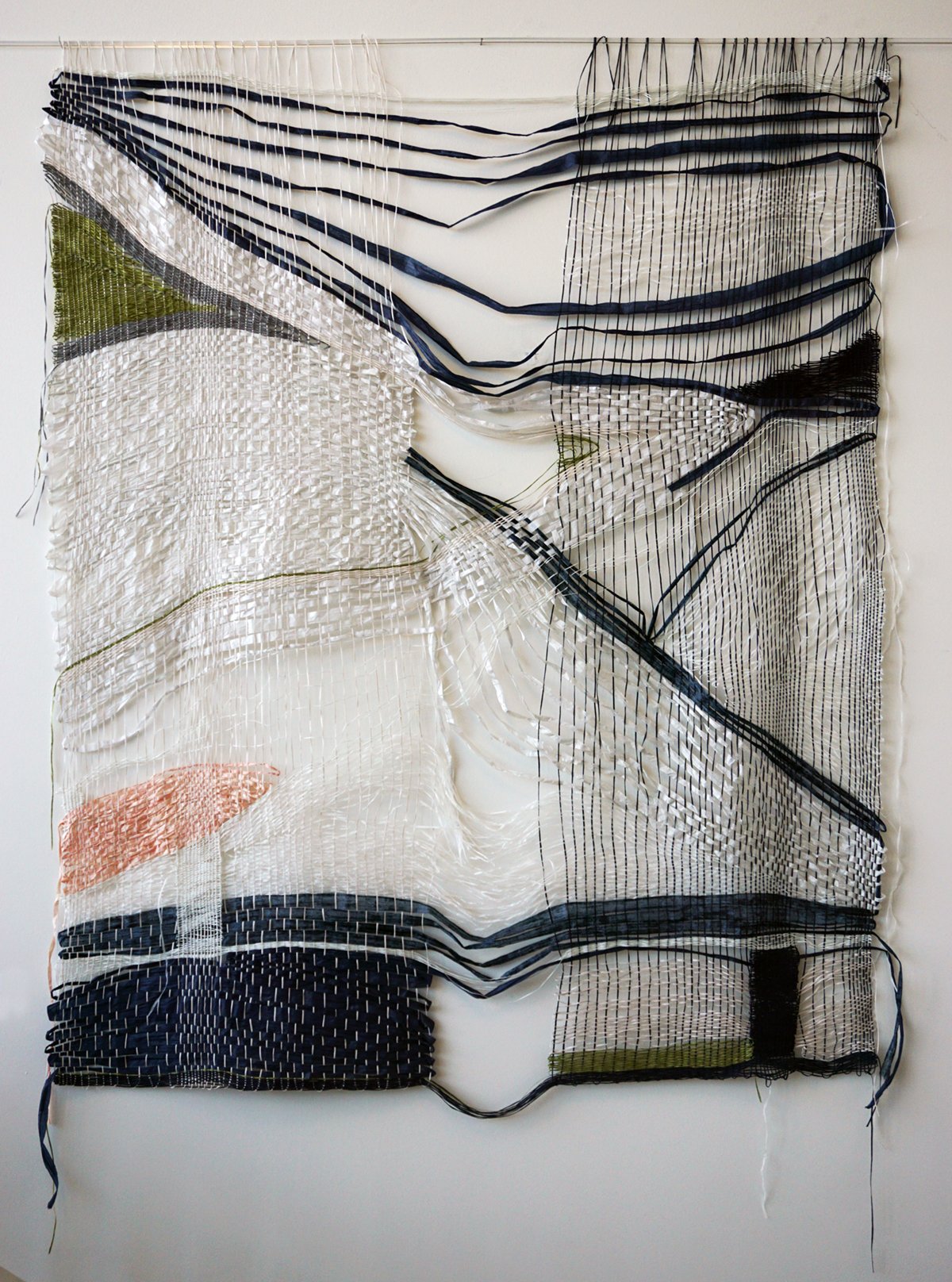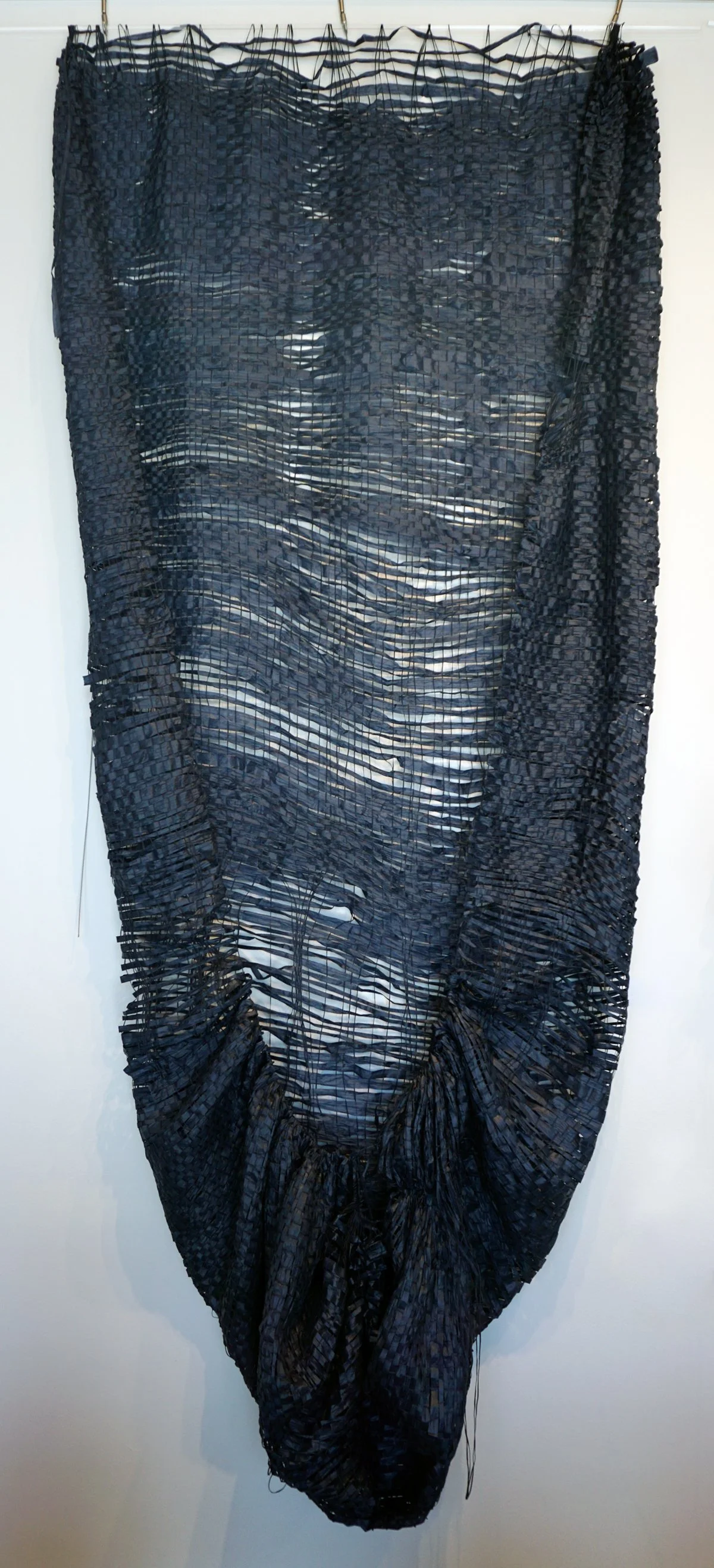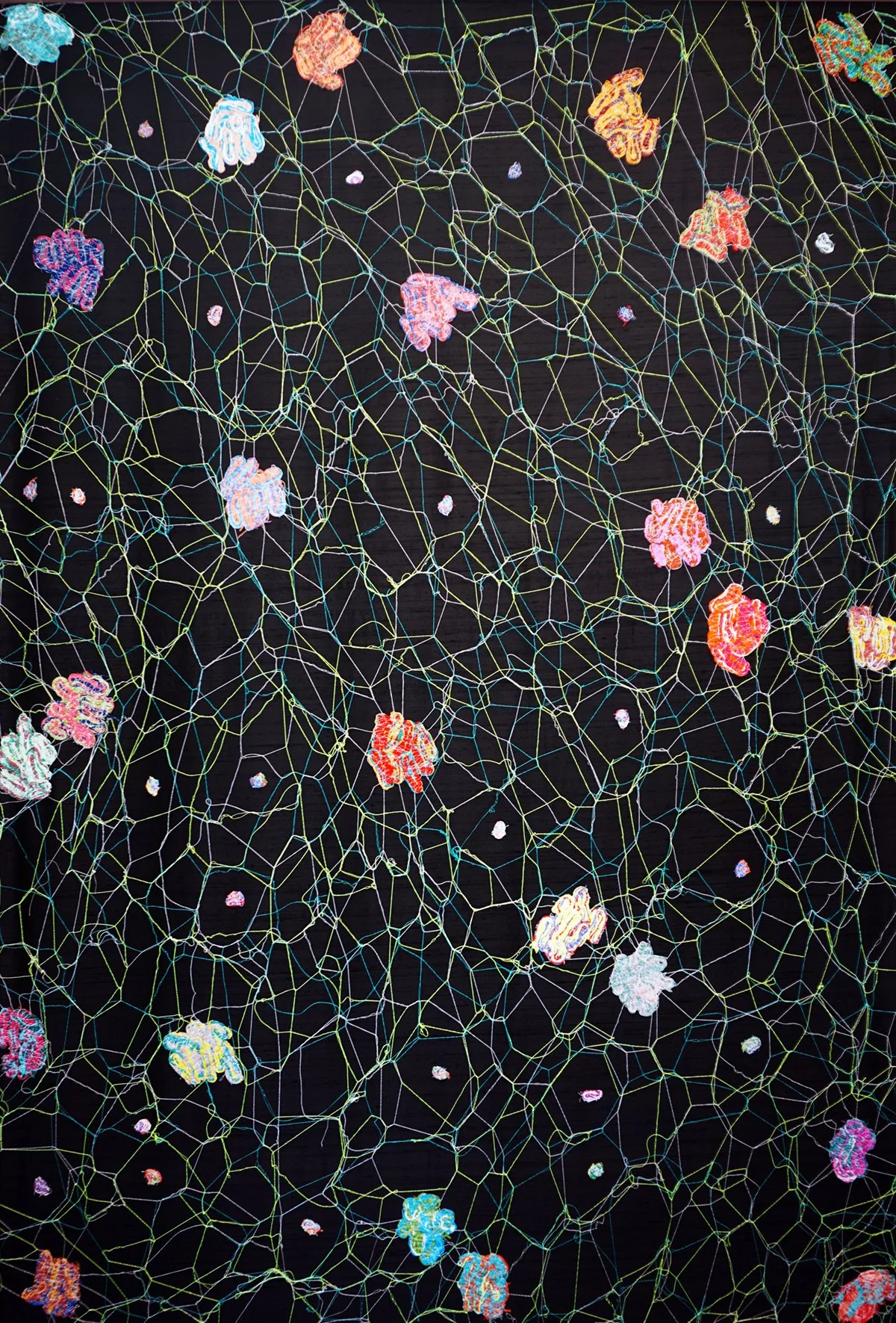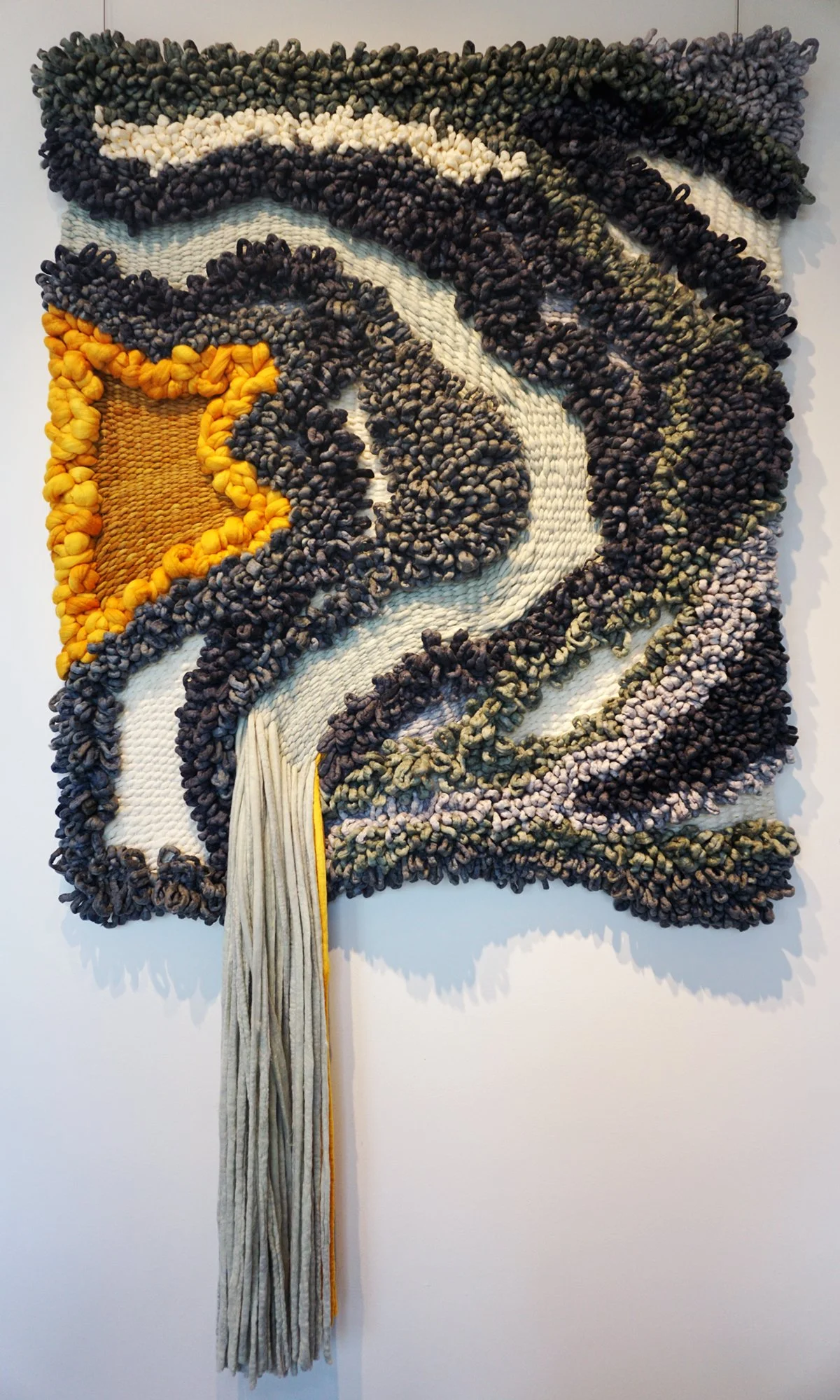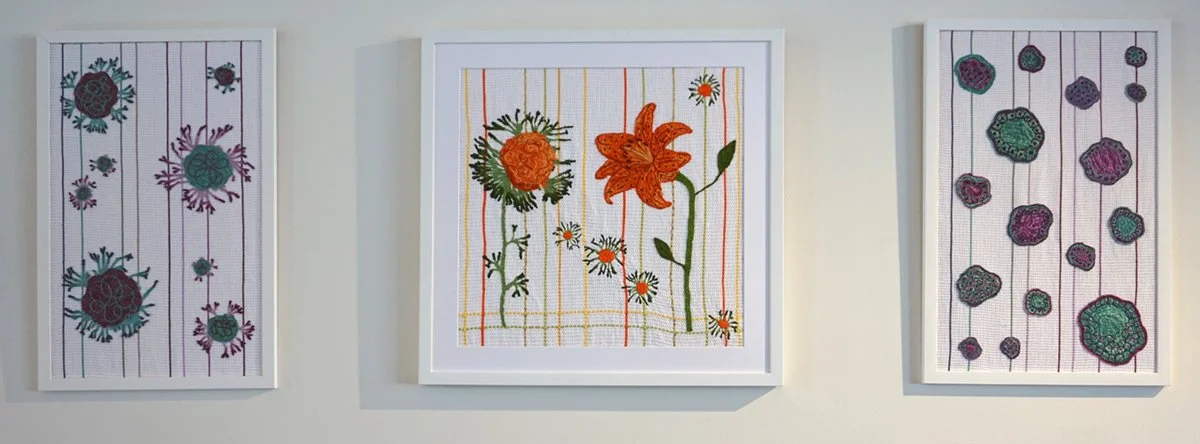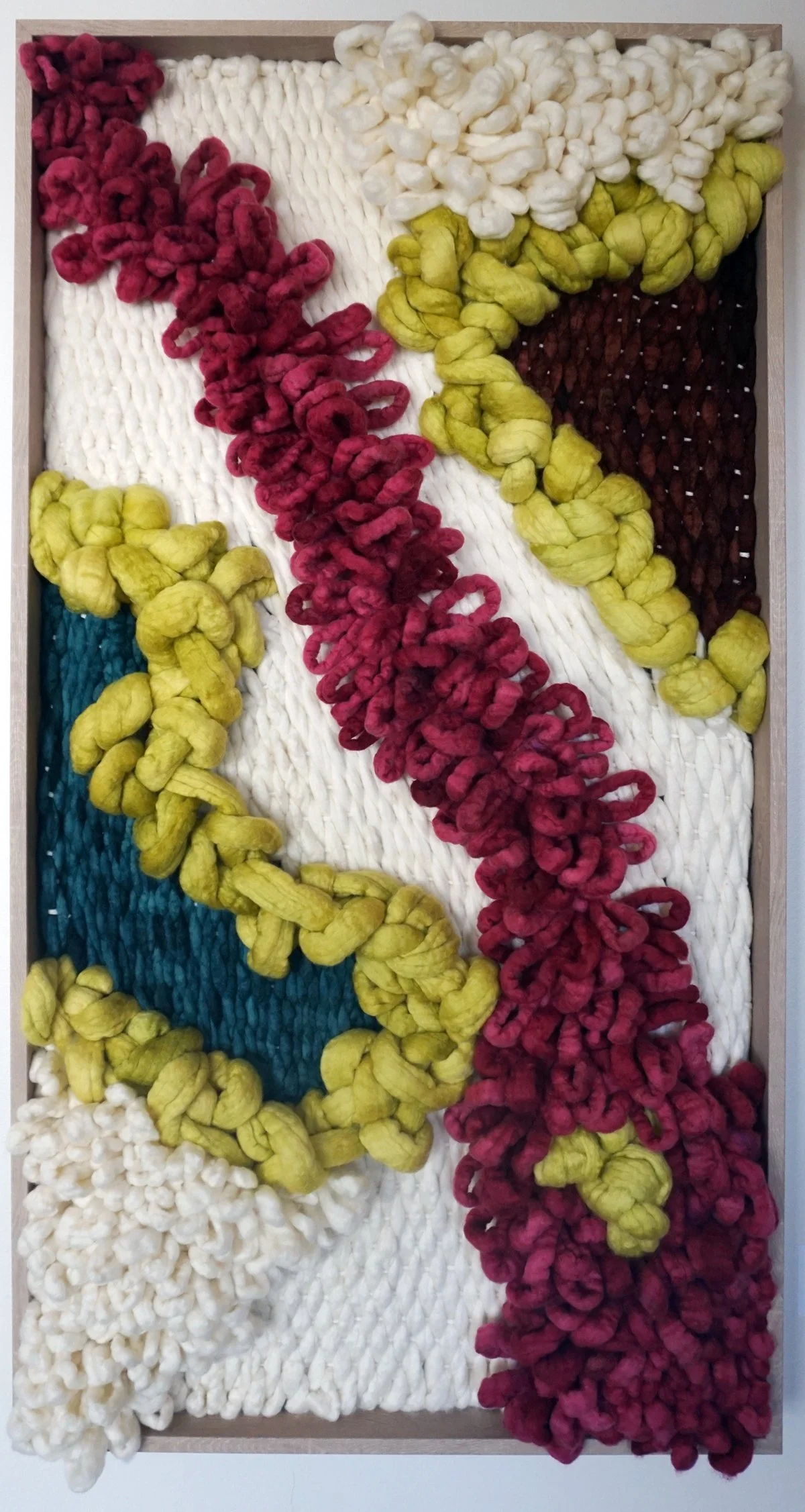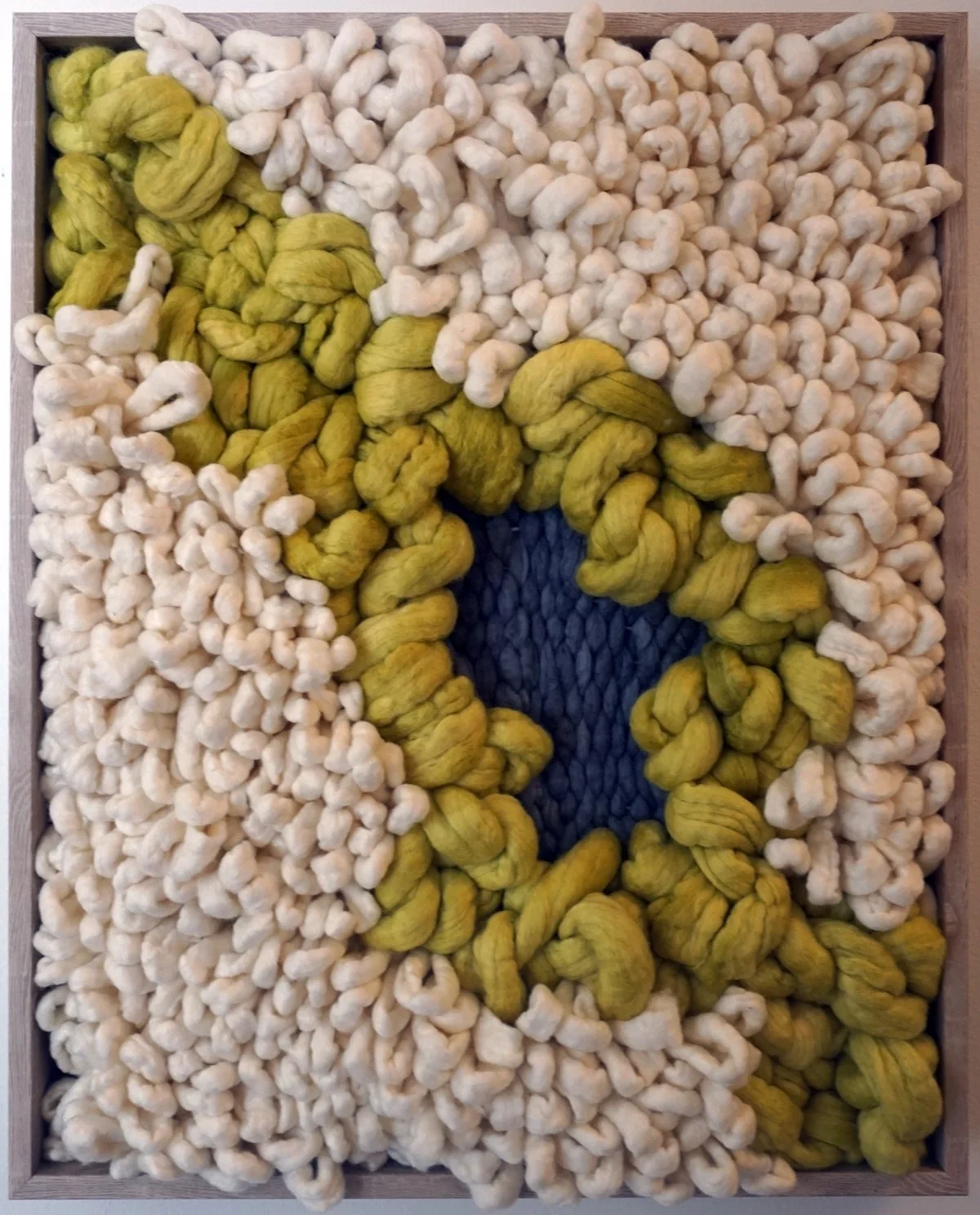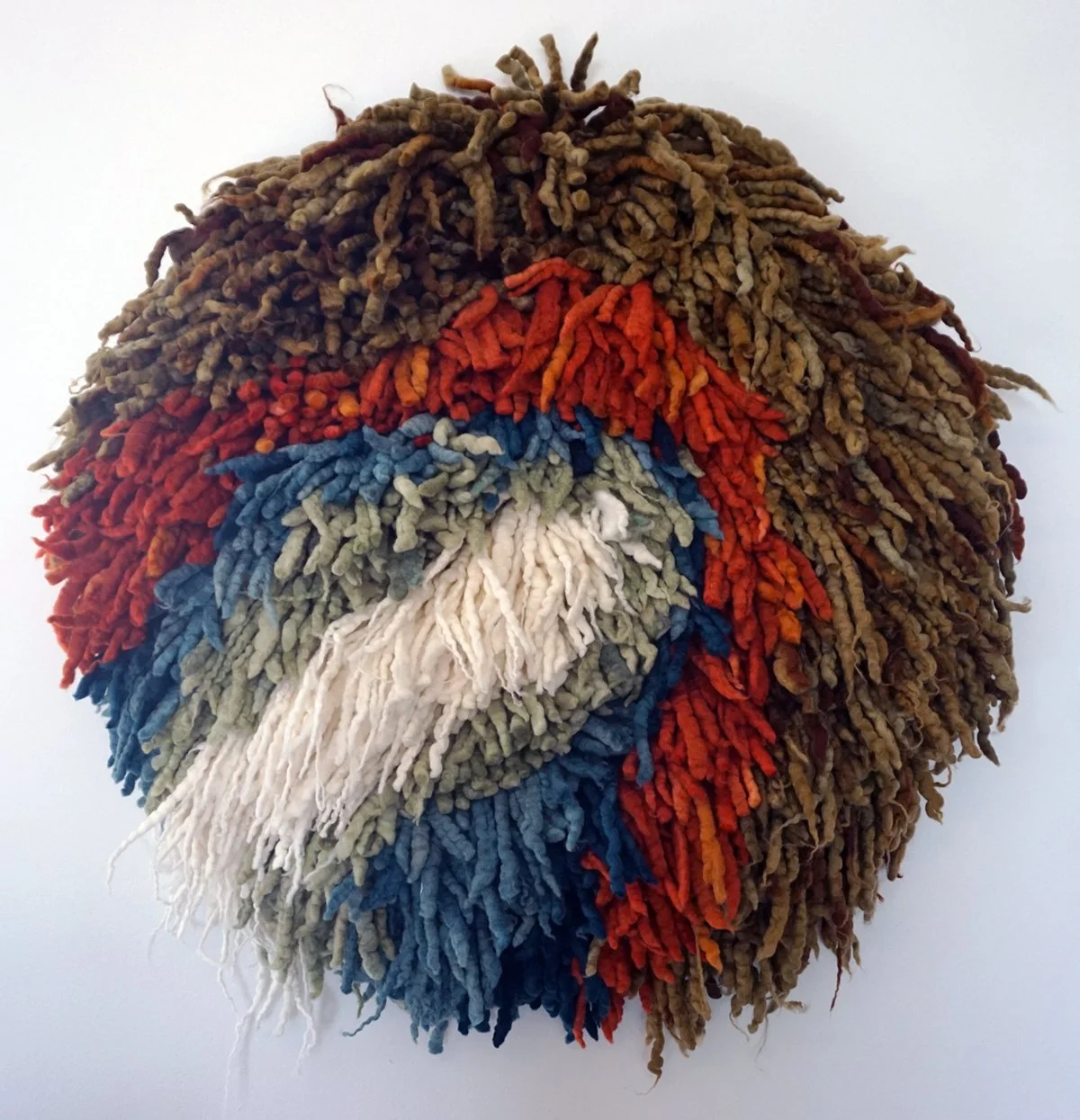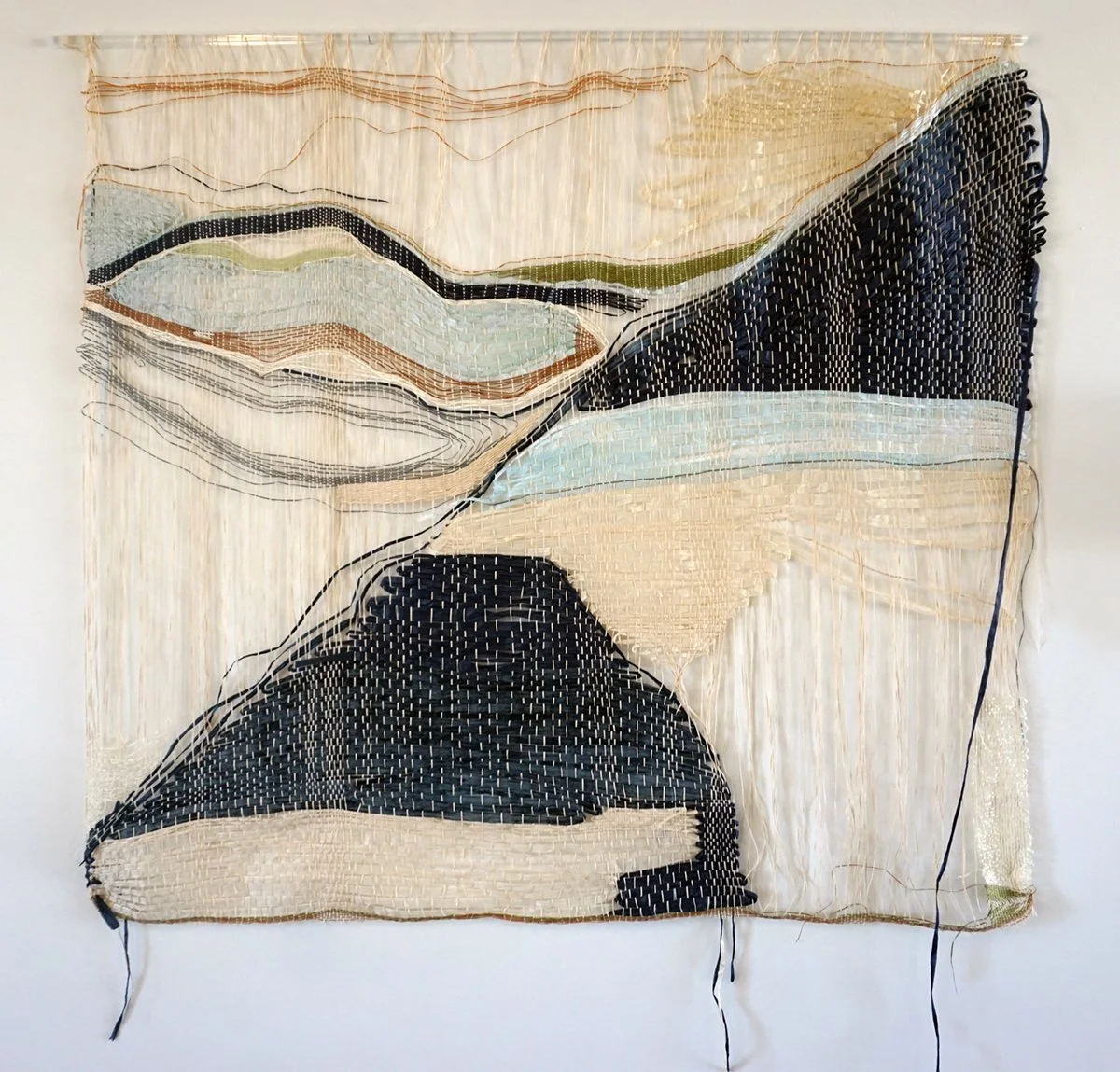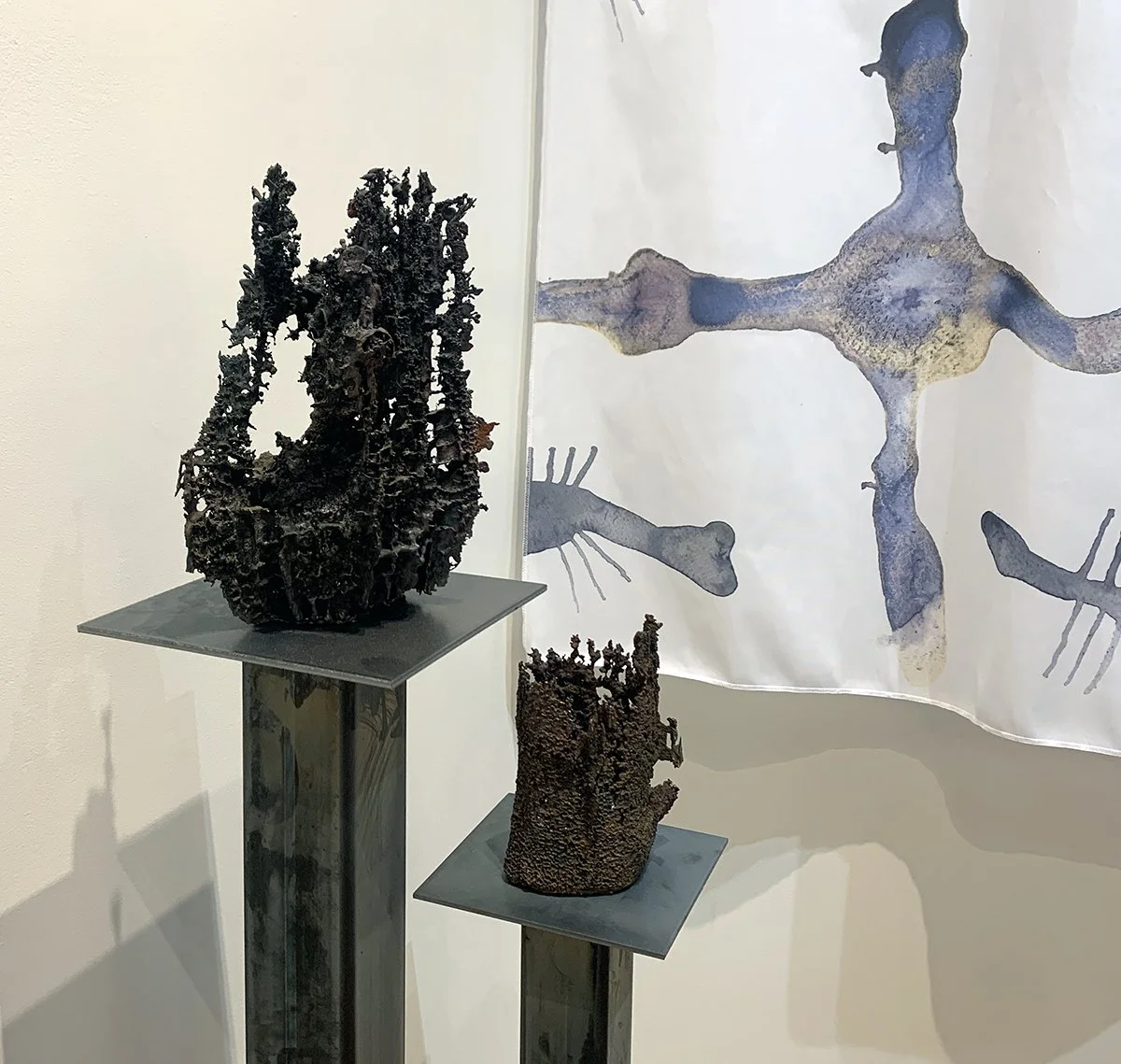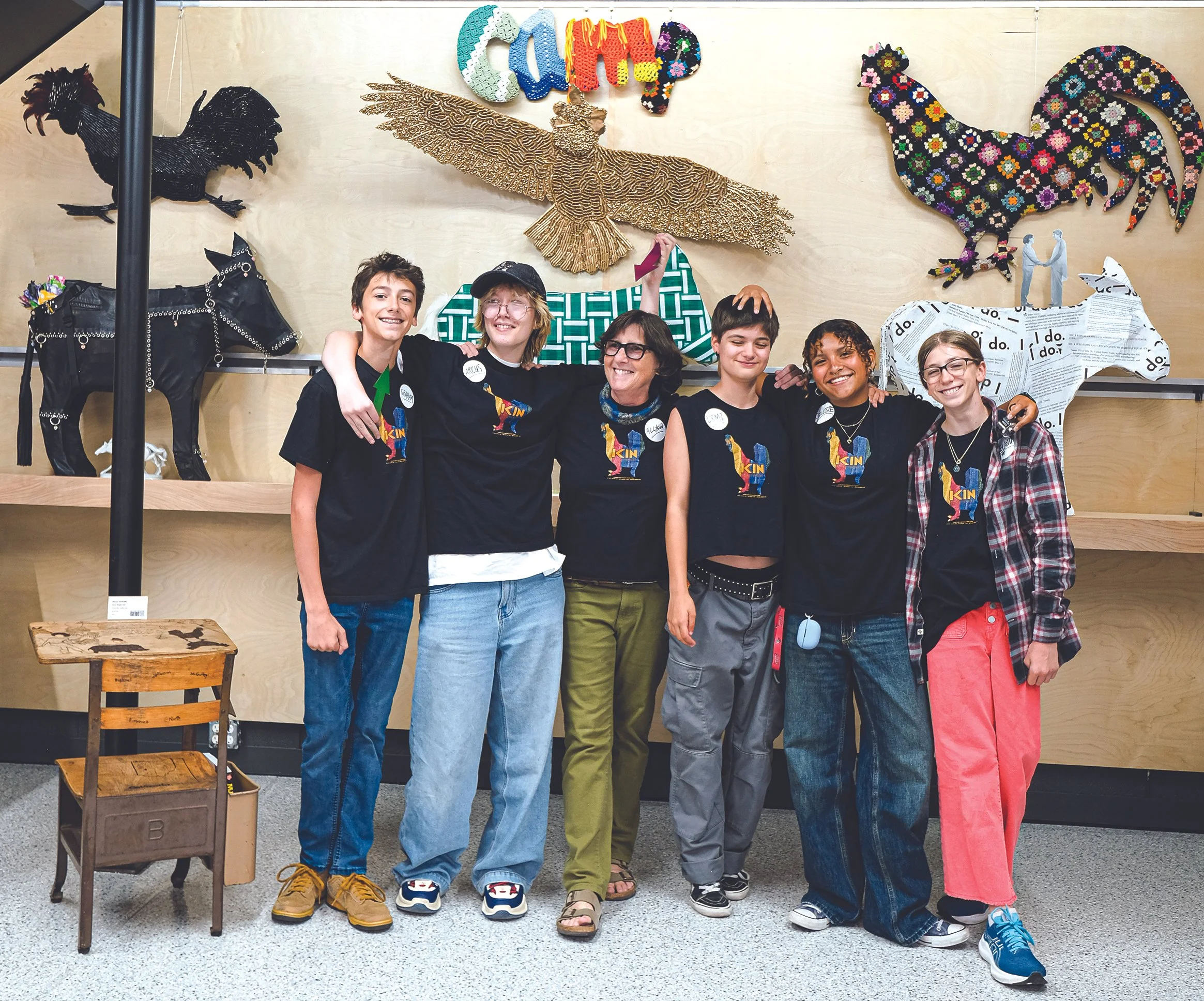Fiber Arts
Fiber Arts: Camille McMurry, Julie Rothschild, Sara Goldenberg White
Messinger Gallery, Boulder Jewish Community Center
6007 Oreg Avenue, Boulder, CO 80303
September 5–December 4, 2025
Admission: free
Review by Madeleine Boyson
Messinger Gallery is airy and inviting, much like the building that houses it. Light from large windows frames walls that display large fiber works, and the contemporary space feels full in an abstracted sort of way. Yet despite the warm welcome I receive from Jen at reception and Jill in Marketing and Communications, I feel professionally out of place as I scribble notes and photograph the artworks on view.
An installation view of Fiber Arts at the Messinger Gallery, inside the Boulder Jewish Community Center, on view through December 4, 2025. Image by Madeleine Boyson.
A reviewer can remain inconspicuous if necessary, but this is the most obtrusive I have been at an exhibition in a while. That’s because Messinger Gallery is not so much a gallery as it is the lobby for the Boulder Jewish Community Center (Boulder JCC)—a point that feels critical to make. The foyer echoes with community and staff members and the sounds of a café. Telephones ring and Dave Matthews Band cranks heavily on the speakers. I hear laughter from the card games upstairs, and note the early childhood class playing across the parking lot.
Julie Rothschild, Crossing, 2025, cotton, linen, bamboo, and watercolor, 48 x 60 inches. Image by Madeleine Boyson.
Amongst this milieu (hustle and bustle), more pertinent to the task at hand (this review), and mirroring its environment (Messinger’s in-between place in the Boulder JCC) is a group exhibition featuring works by Sara Goldenberg White, Camille McMurry, and Julie Rothschild, now on view through December 4. The show brings together three dissimilar yet talented artists under the large (and somewhat flimsy) umbrella of Fiber Arts. The phrase is less title than descriptor: in the absence of curatorial or artist statements, it is unclear what logic dictates a show with these particular creatives beyond their shared media and local ties, even if the grouping is pleasing to the eye.
Julie Rothschild, Navy Blue Bamboo, 2025, bamboo and cotton, 38 x 110 inches. Image by Madeleine Boyson.
While each artist exhibits a similar interest in abstraction, Camille McMurry, Julie Rothschild, and Sara Goldenberg White employ parallel means for achieving disparate ends. But the result is a visually engaging exhibition that yields more questions than answers. For where Fiber Arts lacks a cohesive narrative or conviction, the works and the context in which they are displayed raise a debate about the nature of art and where and when we expect to see it.
Julie Rothschild, Corridors, 2025, cotton, 30 x 120 inches with strands. Image by Madeleine Boyson.
A detail view of Julie Rothschild, Corridors, 2025, cotton, 30 x 120 inches with strands. Image by Madeleine Boyson.
Viewers first are greeted by artist bios that precede four introductory works. Rothschild’s mellifluous weavings Navy Blue Bamboo and Corridors immediately truncate behind waiting room chairs and tables, which shield the lower ends of the two bamboo and cotton tapestries. Navy Blue has been caught up like the skirt of a formal dress while Corridors trails on the floor—an indulgence the traffic in the corridor can ill afford.
Sara Goldenberg White, Cosmically Bound, silk dupioni, embroidery floss, and sewing thread, 63 x 43 inches. Image by Madeleine Boyson.
Goldenberg White and McMurry’s works, by contrast, keep their heads above water, or else mostly above the empty seating. In the former, Cosmically Bound stitches silk dupioni flowers underneath staticky embroidery and thread.
Camille McMurry, In the Flow, hand-dyed and felted merino wool, 4 x 7 feet. Image by Madeleine Boyson.
In the latter, McMurry’s In the Flow follows a river’s meander through hand-dyed and felted merino wool, a topographical consideration that cascades southward like the Colorado River in its more indulgent moments.
Camille McMurry, The Long Becoming, hand-dyed and felted merino wool, 30 inches x 6 feet (each piece). Image by Madeleine Boyson.
This is where Messinger’s location inhibits a traditional gallery experience but maintains other possibilities for experiencing art. On the other side of reception stands McMurry’s duology The Long Becoming—two equally dynamic and three-dimensional tapestries woven in zagging, organic mustard and green. The weavings command attention, but must do double duty in tugging the viewer’s eye leftward across yet another seating area and the building’s main staircase to five more works.
Sara Goldenberg White, left to right: Invasive Cells, cotton thread, copper wire, embroidery floss, and sewing thread, 24 x 16 inches; Tiger Lily, cotton thread, copper wire, embroidery floss, and sewing thread, 23 x 32 inches; and In Situ Cells, cotton thread, copper wire, embroidery floss, and sewing thread, 24 x 16 inches. Image by Madeleine Boyson.
Here Goldenberg White’s Invasive Cells and In Situ Cells recall fellow Boulder artist Julie Maren’s neon Covidia experiments from pandemic lockdown while Tiger Lily hints at more conventional themes and techniques.
Julie Rothschild (left) One in Two Parts - One, 2025, linen, bamboo, silk, copper, and acrylic paint, 58 x 65 inches and (right) One in Two Parts - Two/Layered, 2025, linen, bamboo, silk, copper, and acrylic paint with back layer of cotton and bamboo, 58 x 70 inches. Image by Madeleine Boyson.
To the right are Rothschild’s One in Two Parts - One and One in Two Parts - Two/Layered, which are made of bamboo and linen. The contrast between the two artists’ styles is stark; where Goldenberg White applies restraint to more traditional stitching, Rothschild plays with negative space, contemporaneity, and improvisation to yield multi-layered works that feel simultaneously feathery and foundational.
Sara Goldenberg White, (left) The Divide II, hand-dyed cotton thread, copper wire, embroidery floss, and sewing thread, 34 x 43 inches and (right) The Divide, hand-dyed cotton thread, copper wire, embroidery floss, and sewing thread, 40 x 40 inches. Image by Madeleine Boyson.
Viewers must wander around the stairs to see maroon canvases The Divide I and II, which display more of Goldenberg White’s signature webs, and wander upstairs to see the remaining works in Fiber Arts. Along the stairwell Rothschild shows the ephemeral and soft Crossing while Goldenberg White displays a teal beauty in Bloodflow near the landing.
Camille McMurry, Kitchen Chaos, hand-dyed and felted merino wool, 36 x 18 x 2 inches. Image by Madeleine Boyson.
Camille McMurry, High Noon, hand-dyed and felted merino wool, 16 x 20 inches. Image by Madeleine Boyson.
From there viewers can see McMurry’s remaining bright, sculptural works that spring felted roots and loops from the wall. Kitchen Chaos and High Noon crowd a small bit of wall beside bathrooms and Boulder JCC offices, which renders them both intimate and remote, even inaccessible. It feels strange to stand close enough to view the works while catching whole conversations in the JCC offices, though McMurry’s work is worth the eavesdropping.
Camille McMurry, Undertow, hand-dyed and felted merino wool, 40 inch diameter. Image by Madeleine Boyson.
An installation view of Camille McMurry, Undertow, hand-dyed and felted merino wool, 40 inch diameter. Image by Madeleine Boyson.
On the main landing, McMurry’s Undertow and Rothschild’s Eddying command the space’s attention. The circular Undertow wriggles towards the viewer in felted clumps and points a white strip towards two chairs next to another tall window. Nearby, Rothschild dazzles again with Eddying, the most landscape-esque weaving of the artist’s work in tenuous strips.
Julie Rothschild, Eddying, cotton, linen, bamboo, and watercolor, 60 x 60 inches. Image by Madeleine Boyson.
And so Fiber Arts ends as abruptly as it began, congealing first in the mix-use lobby and then melting into the library stacks upstairs. Messinger Gallery’s credit is in reminding viewers that not every artistic encounter will happen in an intentional, defined, or dedicated area. In fact, those who do not deliberately visit exhibitions will only experience art in situ—a context that necessarily changes what we do with art and why. And though Messinger Gallery ends up feeling like a high-end office lobby with very good decor, this is both an objective of the space and the gallery’s greatest reminder: that art is everywhere and we would do well to provide for more climates than the white cube.
An installation view of the exhibition Fiber Arts at the Messinger Gallery, inside the Boulder Jewish Community Center. Image by Madeleine Boyson.
While I will argue more often than not for a more coherent throughline that transcends obvious media—a container for exhibitions that curates with more than just a discerning eye—Fiber Arts suggests that some of the best art should be seen not only on special occasions, but as a companion of everyday life.
Madeleine Boyson (she/her) is an Editorial Coordinator at DARIA and a Denver-based writer, poet, and artist. She holds a BA in art history and history from the University of Denver.




